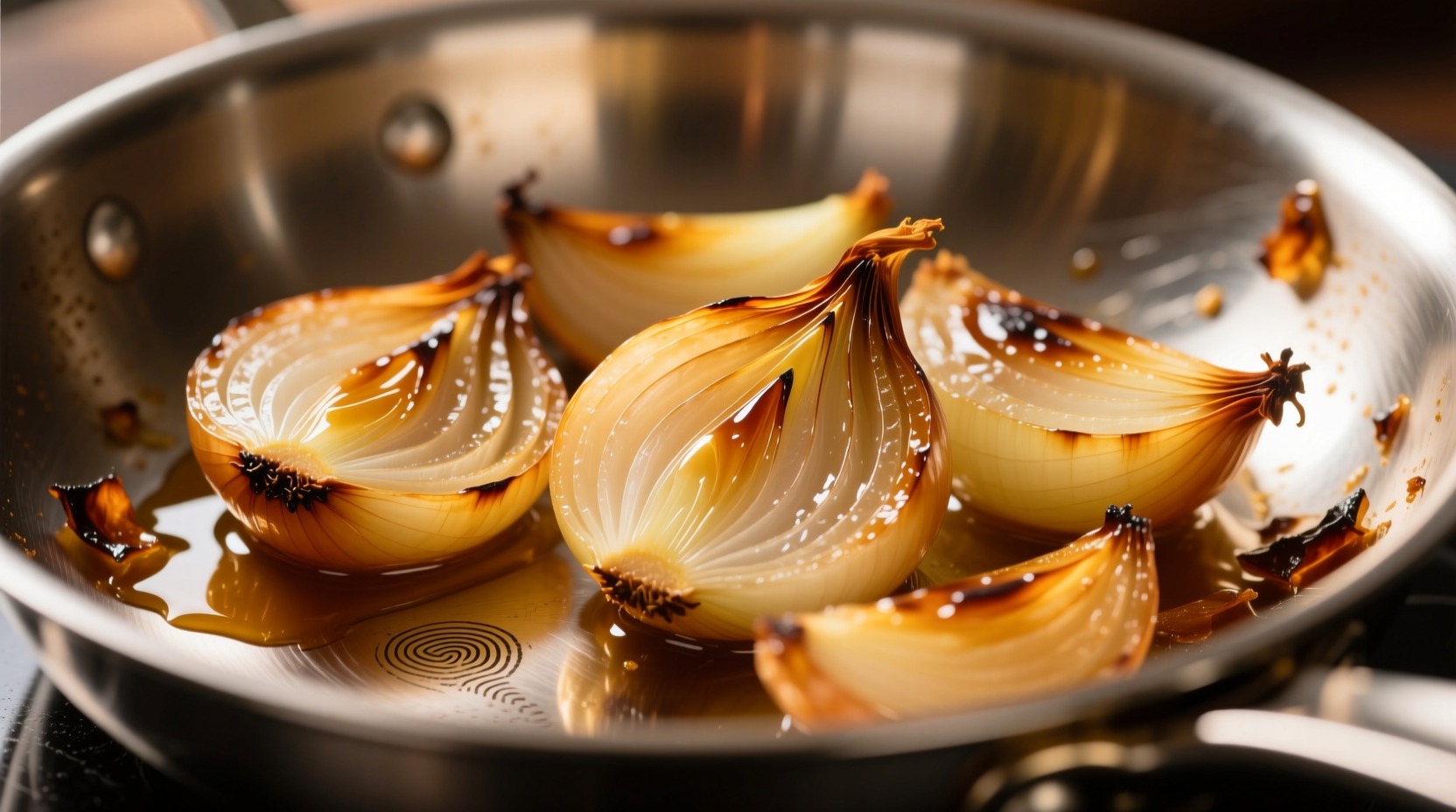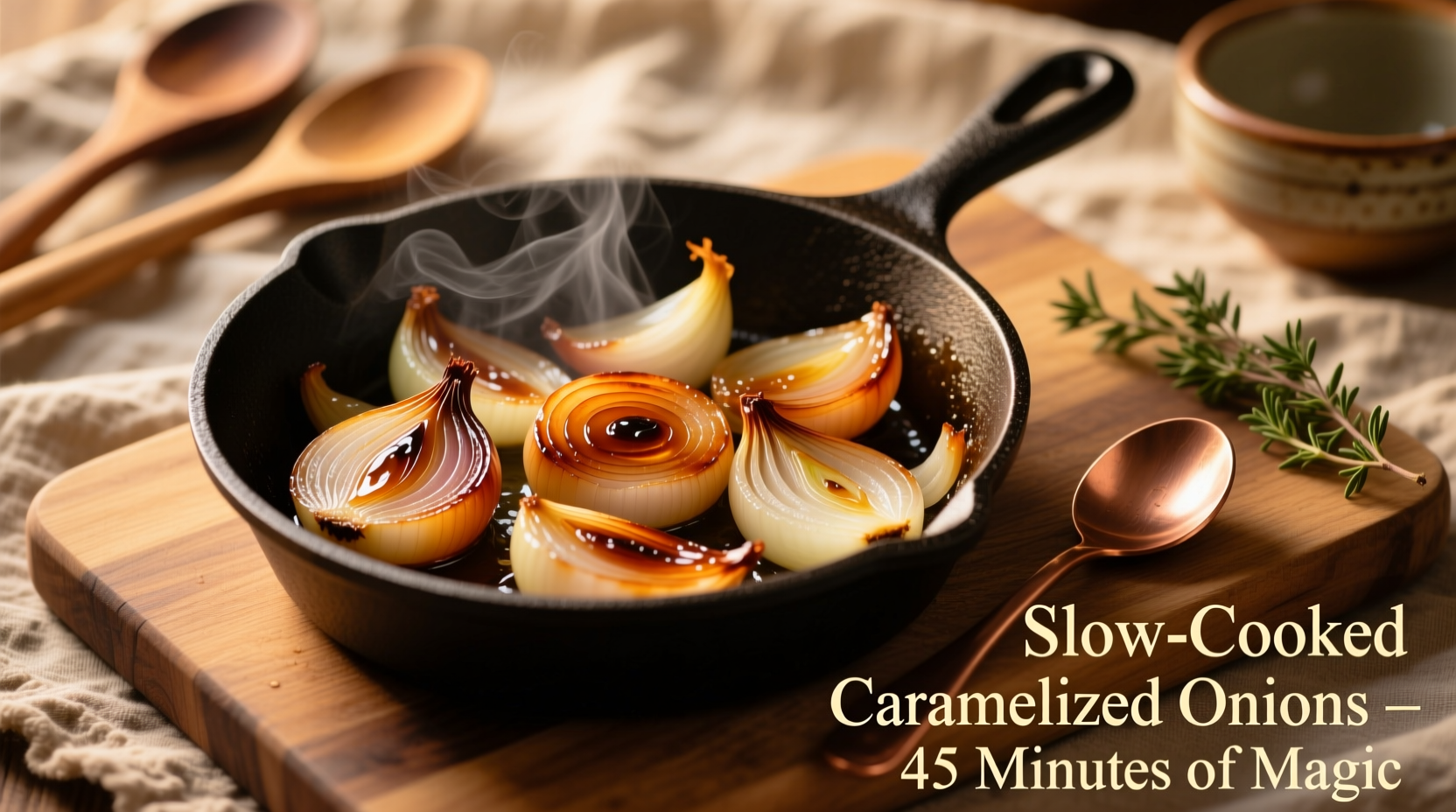The Science Behind Perfect Caramelized Onions
Understanding the Maillard reaction and sugar caramelization explains why patience creates superior results. When onions cook slowly, their natural sugars (fructose and sucrose) break down while amino acids react with reducing sugars through the Maillard reaction. This dual process creates hundreds of new flavor compounds that transform pungent raw onions into sweet, complex, umami-rich toppings.
According to research from the American Chemical Society, the optimal temperature range for onion caramelization is 285-320°F (140-160°C). Exceeding this range causes burning rather than proper caramelization. This explains why many home cooks struggle—they cook too hot, creating bitter compounds instead of sweet complexity.
Essential Tools and Ingredients
You don't need specialty equipment, but the right choices make a difference:
- Pan type: Heavy-bottomed stainless steel or cast iron (avoid non-stick for better fond development)
- Fat options: Butter (rich flavor), olive oil (healthier), or combination (best of both)
- Onion varieties: Yellow onions (classic balance), sweet onions (faster caramelization), red onions (vibrant color)
- Essential tools: Sharp chef's knife, mandoline (for uniform slices), wooden spoon
Step-by-Step Master Technique
Follow this professional method for foolproof caramelized onions every time:
- Prep onions: Slice 3 pounds of yellow onions (about 6 large) uniformly 1/8-inch thick
- Heat pan: Medium-low heat with 2 tablespoons fat (butter or oil)
- Cook initial stage: 10 minutes until onions soften and release liquid
- Reduce heat: To low and continue cooking 30-50 minutes
- Stir occasionally: Every 5-7 minutes, scraping fond from bottom
- Add liquid: 2 tablespoons water, broth, or wine when pan gets too dry
- Finish: Cook until deep golden brown with jam-like consistency

Common Mistakes and Solutions
| Mistake | Why It Happens | Professional Solution |
|---|---|---|
| Burning instead of browning | Heat too high | Reduce to low heat; use thermometer to stay below 320°F |
| Steaming instead of caramelizing | Overcrowded pan | Cook in batches; use wider pan for better evaporation |
| Bitter flavor | Scraping burnt fond | Use wooden spoon to gently loosen fond without scraping char |
| Too much liquid remaining | Insufficient cooking time | Continue cooking; add small amounts of liquid to deglaze as needed |
Flavor Variations to Elevate Your Onions
Professional chefs use these techniques to create distinctive flavor profiles:
- Classic French: Add 1 teaspoon fresh thyme and 1 bay leaf during last 15 minutes
- Balsamic depth: Stir in 2 tablespoons balsamic vinegar during final 10 minutes
- Umami boost: Add 1 tablespoon soy sauce or fish sauce when onions soften
- Spiced version: Include 1/2 teaspoon crushed coriander seeds with onions
- Wine-enhanced: Deglaze with 1/4 cup dry white wine when fond develops
Storage and Usage Ideas
Caramelized onions keep well and enhance countless dishes:
- Refrigeration: Store in airtight container for up to 5 days
- Freezing: Portion into ice cube trays, then transfer to freezer bags for up to 3 months
- Reviving: Gently reheat with teaspoon of water to restore moisture
Use your caramelized onions to elevate:
- Classic French onion soup (essential ingredient)
- Burgers and sandwiches (adds moisture and flavor)
- Pizza toppings (pairs beautifully with goat cheese)
- Omelets and frittatas (adds sweet complexity)
- Grain bowls and roasted vegetables (finishing touch)
Troubleshooting Guide
When things don't go as planned, try these professional fixes:
- Problem: Onions taking too long to caramelize
Solution: Add pinch of sugar to accelerate browning (use sparingly) - Problem: Onions drying out before browning
Solution: Cover pan for first 10 minutes to release moisture, then uncover - Problem: Uneven browning
Solution: Stir more frequently and ensure uniform slice thickness - Problem: Bitter aftertaste
Solution: Add small splash of acid (lemon juice or vinegar) to balance flavors
Frequently Asked Questions
How long do caramelized onions really take to make properly?
True caramelization requires 30-60 minutes of slow cooking. Rushing the process by increasing heat creates bitter, uneven results rather than the deep sweetness of properly caramelized onions. The time investment creates complex flavor compounds that can't be replicated quickly.
Can I use a slow cooker or Instant Pot for caramelized onions?
While possible, slow cookers and Instant Pots don't produce authentic caramelized onions. These methods steam rather than caramelize, missing the critical Maillard reaction that creates complex flavors. For true caramelization, stovetop cooking with proper heat control remains essential.
What's the best onion variety for caramelizing?
Yellow onions provide the best balance of sugar content and pungency for classic caramelized onions. Sweet onions like Vidalia caramelize faster but can become too sweet, while red onions offer beautiful color but slightly different flavor notes. Professional chefs often blend yellow and sweet onions for optimal results.
Why do my caramelized onions sometimes turn out bitter?
Bitterness occurs when onions burn rather than properly caramelize. This happens when heat is too high, causing sugars to焦 rather than slowly transform. To fix bitter onions, add a small amount of acid (lemon juice or vinegar) and a pinch of sugar to balance flavors, but prevention through proper heat control is best.
Can I speed up caramelization with baking soda?
Adding 1/8 teaspoon baking soda can accelerate caramelization by raising pH, but use sparingly as it can create an off-flavor if overused. This technique works best with sweet onions that have higher sugar content. For traditional flavor, patience without additives produces superior results.











 浙公网安备
33010002000092号
浙公网安备
33010002000092号 浙B2-20120091-4
浙B2-20120091-4